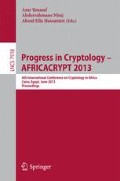Abstract
A new approach to identity-based encryption (IBE), called identity-based factors selection (IBFS), allows to build efficient and fully collusion-resistant IBE schemes without the need for pairings or the use of lattices. The security of these constructions (in the random oracle model) rests on the hardness of a new problem which combines the computational Diffie-Hellman problem with the fact that linear equation systems with more variables than given equations do not have unambiguous solutions. The computational efficiency of the resulting IBE schemes is (for values of the security parameter not smaller than 80) better than in previous IBE schemes. The construction of these schemes may be seen as an extension of the ElGamal public-key encryption scheme. The sender of a message computes the ElGamal-like public key of the message receiver by first selecting, uniquely determined by the identity of the receiver, from a set of group elements \(\{g^{e_1}, ..., g^{e_z} \}\) made available as public parameters a subset, and then multiplying the selected elements.
Access this chapter
Tax calculation will be finalised at checkout
Purchases are for personal use only
Preview
Unable to display preview. Download preview PDF.
References
Abdalla, M., Bellare, M., Rogaway, P.: DHIES: An encryption scheme based on the Diffie-Hellman Problem. In: Extended Version of [2], September 18 (2001), http://www.cs.ucdavis.edu/~rogaway/papers/dhies.pdf
Abdalla, M., Bellare, M., Rogaway, P.: The oracle Diffie-Hellman assumptions and an analysis of DHIES. In: Naccache, D. (ed.) CT-RSA 2001. LNCS, vol. 2020, pp. 143–158. Springer, Heidelberg (2001)
Agrawal, S., Boneh, D., Boyen, X.: Efficient lattice (H)IBE in the standard model. In: Gilbert, H. (ed.) EUROCRYPT 2010. LNCS, vol. 6110, pp. 553–572. Springer, Heidelberg (2010)
Bellare, M., Rogaway, P.: Random oracles are practical: A paradigm for designing efficient protocols. In: Proc. of 1st ACM Conference on Computer and Communications Security, pp. 62–73. ACM (1993)
Bentahar, K., Farshim, P., Malone-Lee, J., Smart, N.: Generic constructions of identity-based and certificateless KEMs. Journal of Cryptology 21(2), 178–199 (2008)
Bertoni, G., Daemen, J., Peeters, M., van Assche, G.: The Keccak reference, version 3.0, January 14 (2011), http://keccak.noekeon.org/Keccak-reference-3.0.pdf
Boneh, D., Boyen, X.: Efficient selective identity-based encryption without random oracles. Journal of Cryptology 24(4), 659–693 (2011)
Boneh, D., Franklin, M.: Identity-based encryption from the Weil pairing. SIAM Journal on Computing 32(3), 586–615 (2003)
Boneh, D., Gentry, C., Hamburg, M.: Space-efficient identity based encryption without pairings. In: Proc. of 48th Annual IEEE Symposium on Foundations of Computer Science (FOCS 2007), pp. 647–657 (2007) ISBN 0-7695-3010-9
Boyen, X.: A tapestry of identity-based encryption: practical frameworks compared. Int. Journal of Applied Cryptography (1), 3–21 (2008)
Certicom Research: Standards for efficient cryptography, SEC 1: Elliptic Curve Cryptography, Version 2.0, May 21 (2009), http://www.secg.org/download/aid-780/sec1-v2.pdf
Chatterjee, S., Sarkar, P.: Identity-Based Encryption. Springer (2011) ISBN 978-1-44199-382-3
Chen, L., Cheng, Z., Malone-Lee, J., Smart, N.P.: An efficient ID-KEM based on the Sakai–Kasahara key construction. IEE Proc. Information Security 153, 19–26 (2006)
Cocks, C.: An identity based encryption scheme based on quadratic residues. In: Honary, B. (ed.) Cryptography and Coding 2001. LNCS, vol. 2260, pp. 360–363. Springer, Heidelberg (2001)
Diffie, W., Hellman, M.: New directions in cryptography. IEEE Trans. on Information Theory 22, 644–654 (1976)
ElGamal, T.: A public-key cryptosystem and a signature scheme based on discrete logarithms. IEEE Trans. on Inform. Theory 31(4), 469–472 (1985)
Galbraith, S.D., Paterson, K.G., Smart, N.P.: Pairings for cryptographers. Discrete Applied Mathematics 156(16), 3113–3121 (2008)
Gentry, C., Peikert, C., Vaikuntanathan, V.: Trapdoors for hard lattices and new cryptographic constructions. In: Proc. of the 40th ACM Symposium on Theory of Computing (STOC 2008), pp. 197–206. ACM (2008)
Gentry, C., Silverberg, A.: Hierarchical ID-based cryptography. In: Zheng, Y. (ed.) ASIACRYPT 2002. LNCS, vol. 2501, pp. 548–566. Springer, Heidelberg (2002)
Hankerson, D., Menezes, A., Vanstone, S.: Guide to elliptic curve cryptography. Springer (2004) ISBN 0-387-95273-X
Joux, A.: A one round protocol for tripartite Diffie-Hellman. Journal of Cryptology 17(4), 263–276 (2004)
Maurer, U., Yacobi, Y.: A non-interactive public-key distribution system. Designs, Codes and Cryptography 9(3), 305–316 (1996)
Menezes, A., van Oorschot, P., Vanstone, S.: Handbook of applied cryptography, 5th edn. CRC Press (2001) ISBN 0-8493-8523-7
Paterson, K.G., Srinivasan, S.: On the relations between non-interactive key distribution, identity-based encryption and trapdoor discrete log groups. Designs, Codes and Cryptography 52(2), 219–241 (2009)
Shamir, A.: Identity-based cryptosystems and signature schemes. In: Blakely, G.R., Chaum, D. (eds.) CRYPTO 1984. LNCS, vol. 196, pp. 47–53. Springer, Heidelberg (1985)
Yacobi, Y.: A note on the bilinear Diffie-Hellman assumption, IACR Cryptology ePrint Archive, Report 2002/113 (2002), http://eprint.iacr.org/2002/113
Author information
Authors and Affiliations
Editor information
Editors and Affiliations
Rights and permissions
Copyright information
© 2013 Springer-Verlag Berlin Heidelberg
About this paper
Cite this paper
Staamann, S. (2013). An Identity-Based Key-Encapsulation Mechanism Built on Identity-Based Factors Selection. In: Youssef, A., Nitaj, A., Hassanien, A.E. (eds) Progress in Cryptology – AFRICACRYPT 2013. AFRICACRYPT 2013. Lecture Notes in Computer Science, vol 7918. Springer, Berlin, Heidelberg. https://doi.org/10.1007/978-3-642-38553-7_23
Download citation
DOI: https://doi.org/10.1007/978-3-642-38553-7_23
Publisher Name: Springer, Berlin, Heidelberg
Print ISBN: 978-3-642-38552-0
Online ISBN: 978-3-642-38553-7
eBook Packages: Computer ScienceComputer Science (R0)

